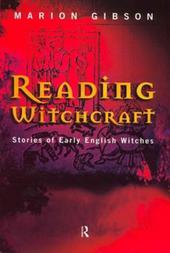
|
Reading Witchcraft: Stories of Early English Witches
Paperback
Main Details
| Title |
Reading Witchcraft: Stories of Early English Witches
|
| Authors and Contributors |
By (author) Marion Gibson
|
| Physical Properties |
| Format:Paperback | | Pages:256 | | Dimensions(mm): Height 234,Width 156 |
|
| Category/Genre | Witchcraft
Satanism and demonology |
|---|
| ISBN/Barcode |
9780415206464
|
| Classifications | Dewey:133.430942 |
|---|
| Audience | | Undergraduate | | Postgraduate, Research & Scholarly | | Professional & Vocational | |
|---|
|
Publishing Details |
| Publisher |
Taylor & Francis Ltd
|
| Imprint |
Routledge
|
| Publication Date |
6 May 1999 |
| Publication Country |
United Kingdom
|
Description
Exploring the stories told by and about "witches" and their "victims", this text questions what can be recovered from their trial records, early news books, pamphlets and personal accounts. In her wide-ranging selection of original sources, Marion Gibson seeks to discover the truthfulness of stories of witchcraft. Who told them and why? How were they recorded? And how might they have been distorted or stereotyped? This book looks closely at these legal documents and printed pamphlets and shows that their representations of witchcraft are far from straightforward. Even the simplest story can mask a complex creative process which sometimes led to the deaths of innocent people. We are left with a record of the power of the human imagination.
Reviews"Future scholars will be indebted to her book, and invaluable manual and "vade mecum as well as an original, important and stimulating monograph."
-"American Historical Review
"Several years ago the university of Exter began an interdisciplary Master's Degree progam in history and literature of witchcraft. This book, whose author is a lecturer at Exeter, demonstrates some of the intentions of that program. On the surface of it, "Reading "Witchcraft has an interesting and provocative premise. The Author has taken the relatively small body of Jacobean and early Elizabethan wotchcraft pamphlets and proposed that these documents are important and need to be taken seriously. This reviewer looked forward to a careful analytical presentation of some of the documents, a rpesentation written in the light of the multidisciplinary program at Exeter.."
"Such an approach to the study of the witchcraft pamphlets is nothing new. Scholars working in the area of English witchcraft studies know these documents virtually from emmory. Earlier historians have suggested we use these pamphlets as important primary documents and have analyzed them. They were presented by C. L'Estrange Ewen in his anthology, "Witchcraft and Demonology, in 1933. But, it is certainly worthwhile to encourage a detailed study of these documents and to not dismiss them out of hand as being bits of inflammatory and sensational popular literature. Gibson proposes furhter that the documents need careful examination and categorizing "deconstruction" as she puts it, to help the historian or sociologist evaluate the data presented. This approach also soed not present a problem. Questions to be asked include: What exactly was awitchcraft pamphlet?."
"Are we to take these documents as faithful descriptions of "witches"? Can we say that these documents present "reality" from their questioning sessions, and lastly their trials? Can we determine anything from a study of the authors of the pamphlets. What were the motivies of the authors? How close were they to the actual events of a witch's arrest and trial? Did the pamphlets change as time passed? Such ar eGibson's concerns. Again, these are not new concerns for a historian, but it is worthwhile mentioning them from time to time for the enlightenment of the student or colleague.."
"The reader's problem arises in part with the arrangenemt of "Reading Witchcraftitself. this seems to be two different books uneasily wover together. On the one hand we have a sort of "Dummies Guide to Interpreting Witchcraft Pamphlets" and on the other hand we have a lengthy historiography essay about a large number of recent authors who have wtried to deal with these pamphlets. One would wish the author had put her own proposed methods of analysis into pratice more with selected specific documents ahd had left aside some of the histography. Or, if this was not possible, then one wishes that she had written a longer book naturally divided into two parts to present these two components in greater detail.."
|